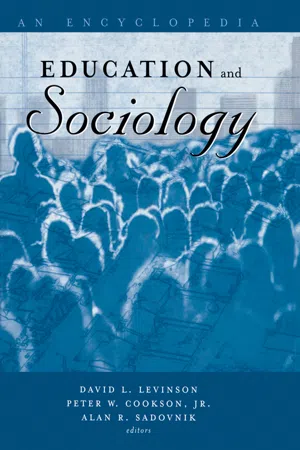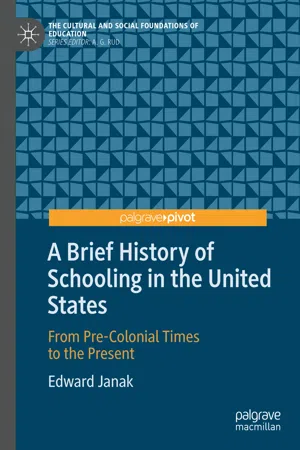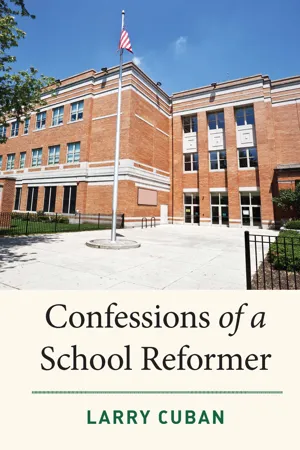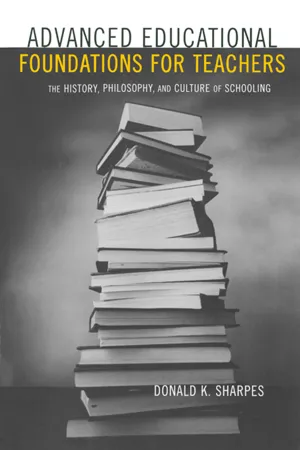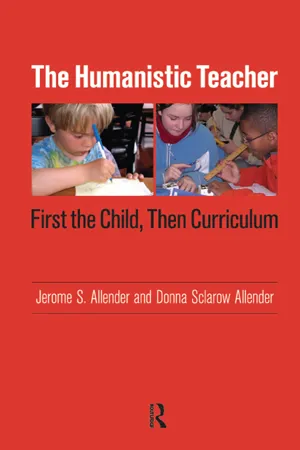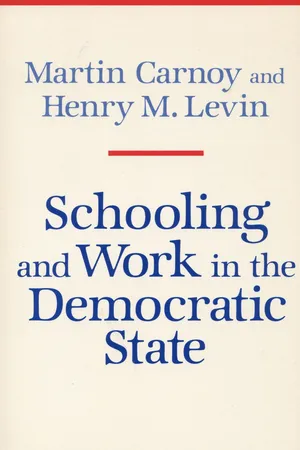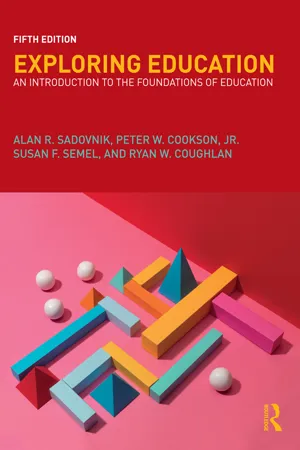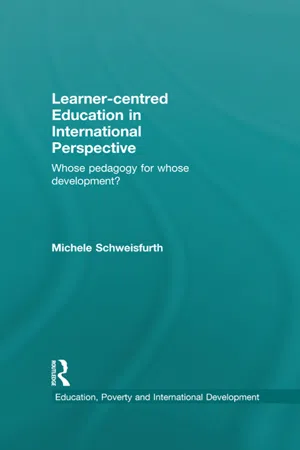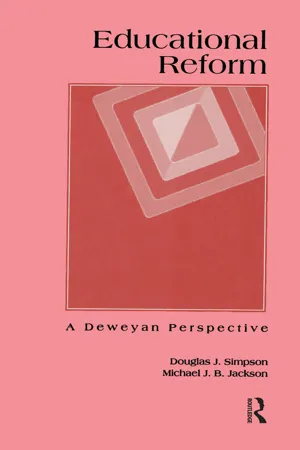History
Progressive Education
Progressive education is an educational philosophy that emphasizes learning through experience, critical thinking, and problem-solving. It emerged in the late 19th and early 20th centuries as a response to traditional, authoritarian teaching methods. Progressive educators advocate for a more student-centered approach, focusing on individual needs and interests to promote active engagement and holistic development.
Written by Perlego with AI-assistance
Related key terms
10 Key excerpts on "Progressive Education"
- eBook - ePub
Progressive Museum Practice
John Dewey and Democracy
- George E Hein(Author)
- 2016(Publication Date)
- Routledge(Publisher)
Only later was the movement taken over by professional educators who were more interested in the development of individual children, and who laid greater emphasis on educational opportunities for their middle class clients than on social and political issues. The term “progressive” (as applied to education) became a descriptor of only the pedagogic principles, and in the public mind was disassociated from the application of the term to a means for developing a socially Progressive society. As Patricia Graham points out in her history of the Progressive Educational Association (PEA): 6 Prewar [World War I] educational progressivism was a movement essentially continuous with the social and political progressivism that flourished in the last quarter of the nineteenth century. It had for a major object the expansion of public school facilities and curriculum offerings with a view to accommodating the children of the working class, removing obstacles from their path of entry into full participation in American life. Postwar Progressive Education bloomed in private schools and, although it was later taken over by educational professionals, its reforms from first to last appealed primarily to the middle and upper classes. (Graham 1967, 11–12) During the depression of the 1930s, a struggle between socially inclined and child-centered proponents continued within the PEA, and also in the larger educational world, with an especially strong revival of concern for the social mission of schools (see Cremin 1971, 224–234). A parallel phenomenon was also occurring concurrently in the museum world. A noteworthy aspect of American Progressivism is that as a political movement—there have been three specific national political parties using that name over half a century 7 —it never challenged capitalism, nor did it call for an end to private ownership of means of production - eBook - ePub
Education and Sociology
An Encyclopedia
- David Levinson, Peter Cookson, Alan Sadovnik(Authors)
- 2014(Publication Date)
- Routledge(Publisher)
Perhaps these debates can be best understood by examining reform cycles of the twentieth century, which revolved between progressive and traditional visions of schooling. On the one hand, traditionalists believed in knowledge-centered education, a traditional subject-centered curriculum, teacher-centered education, discipline and authority, and the defense of academic standards in the name of excellence. On the other hand, progressives believed in experiential education, a curriculum that responded to both the needs of students and the times, child-centered education, freedom and individualism, and the relativism of academic standards in the name of equity. Although these poles and educational practices rarely were in only one direction, the conflicts over educational policies and practices seemed to move back and forth between these two extremes. From 1945 to 1955, the Progressive Education of the previous decades was critically attacked.These critics, including Mortimer Smith, Robert Hutchins, and Arthur Bestor, assailed Progressive Education for its sacrificing of intellectual goals to social ones. They argued that the life adjustment education of the period combined with an increasingly antiintellectual curriculum destroyed the traditional academic functions of schooling. Arthur Bestor, a respected historian and a graduate of the Lincoln School, one of the early progressive schools in New York City, argued that it was “regressive education” not Progressive Education that had eliminated the school’s primary role in teaching children to think (Ravitch, 1983:76). Bestor, like the other critics, assailed the schools for destroying the democratic vision that all students should receive an education that was once reserved for the elite. He suggested that the social and vocational emphasis of the schools indicated a belief that all students could not learn academic material. In an ironic sense, many of the conservative critics were agreeing with the radical critique that the Progressive Era distorted the ideals of democratic education by tracking poor and working class children into nonacademic vocational programs.Throughout the 1950s the debate between progressives who defended the social basis of the curriculum and critics who demanded a more academic curriculum raged on. What was often referred to as “the great debate” (Ravitch, 1983:79) ended with the Soviet launching of the space satellite Sputnik. The idea that the Soviets would win the race for space resulted in a national commitment to improve educational standards in general and to increase mathematical and scientific literacy in particular. From 1957 through the mid-1960s, the emphasis shifted to the pursuit of excellence and curriculum reformers attempted to redesign the curricula in ways that would lead to the return of academic standards (although many doubted that such a romantic age ever existed). - eBook - ePub
A Brief History of Schooling in the United States
From Pre-Colonial Times to the Present
- Edward Janak(Author)
- 2019(Publication Date)
- Palgrave Pivot(Publisher)
Eventually, there were distinct camps within the Progressive Education movement. One group, the child-centered progressives, focused on overhauling the practices of teaching—the curricula, pedagogy, and management. A group of progressive scholars came together in 1919 to form the Progressive Education Association (PEA), a group whose mission was “reforming the entire school system of America.” Beyond Dewey, progressive thinkers included William Heard Kilpatrick, who in 1913 invented the project method. Kilpatrick defined the project as a purposeful act that demonstrates a worthy life in a democratic society. He presented four types of projects in which students could engage: they could embody some idea or plan (make something), enjoy some aesthetic experience (appreciate something), solve some problem (fix something), or obtain some degree of skill (learn to do something). Another example was Hilda Taba, a student of John Dewey, who focused on development of curriculum. Taba encouraged teachers to become mediators rather than lecturers, to lead the discussion rather than predetermine the curriculum. Today, Taba’s focus on collaboration is alive and well within the classroom, reflected through educators who employ critical pedagogy to account for dynamics of power and privilege that have traditionally placed instructors in positions of power over students. In a successful attempt at proving that their ideas were solid, the PEA launched the Eight-Year Study, in which students in 30 high schools across the United States were taught using completely progressive techniques. There was no set curriculum, no set courses, no set texts, and so on. The study mapped university progress of students from this system compared with their peers from more traditional schools. The results were that students from the progressive school were advanced socially and on par academically - eBook - ePub
- Larry Cuban(Author)
- 2022(Publication Date)
- Harvard Education Press(Publisher)
CHAPTER 1 The Progressive Movement (1890s–1940s)THERE IS A “SHORT” AND A “LONG” STORY to American reform movements. Consider the Progressive movement. Most historians find its beginnings in the closing decades of the nineteenth century, when reformers identified serious problems arising from an emergent industrial economy, burgeoning cities with corrupt municipal governments, and crowds of immigrants congregating in slums.1Because traditional schools of the time were out of step with the changed economy and society, Progressive educators sought to remake schools into efficient places that looked at the whole child and prepared that child to enter an entirely different workplace and civic life than their parents and grandparents ever knew. Historians generally agree that this Progressive movement lasted through the Great Depression and the New Deal, winding down by World War II. This is the “short” story of a national reform movement that included efforts to transform traditional schools to meet new economic, political, and social demands.But there is a “long” story to the educational side of the Progressive movement. That long story takes one back to the eighteenth century, when Jean-Jacques Rousseau wrote Emile and Swiss educator Johann Heinrich Pestalozzi penned How Gertrude Teaches Her Children , and to the nineteenth century, when German educator Friedrich Froebel introduced the concept of the kindergarten . All of these European writers sought a schooling that centered on the head, heart, and hands of children to explore their interests and to get them to think and engage with the world outside of the classroom. School was more than a preparation for life or work, they believed.2Their ideas crossed the Atlantic and took root among American thinkers and educators such as communitarian Robert Owen, essayist Ralph Waldo Emerson, kindergarten advocate Elizabeth Peabody, and district superintendent Colonel Francis W. Parker. The ideas and practices of these early Progressives were picked up and reshaped to fit an industrial democracy by John Dewey and other educational reformers in the closing decades of the nineteenth century.3 - eBook - ePub
Advanced Educational Foundations for Teachers
The History, Philosophy, and Culture of Schooling
- Donald K. Sharpes(Author)
- 2013(Publication Date)
- Routledge(Publisher)
William Holmes McGuffey (1800-1873) had been rural schoolteacher and became a professor of languages at Miami University in Ohio, and then president of Cincinnati College and Ohio University. His remaining years were spent at the University of Vuginia (1845-73). But he is best remembered for his development of this highly successful set of six readers, which were constantly revised and updated, and still in wide circulation in the 1930s because Henry Ford, the inventor of the automobile who had himself used it in school, saw that it was generously reprinted. The total estimated sales were 122 million copies over two generations. But the influence on the mentality of schooling has been profound and has shaped the perception of a common American culture all reading literally from the same text.American Educational Philosophies
The Progressive Education Association began in the United States in 1919 and began to falter in favor only in the 1970s. The movement incorporated the ideas that favored the individual over the knowledge base in curriculum and instruction. The guiding principles were that education works best when the child’s interests are considered, and when actual performance results from learning. Individual differences, an idea found in Darwin, were also one of the governing concepts. The works of John Dewey best exemplify the ideas found in the educational theory of progressivism. The central figure in this movement was John Dewey.Progressivism: The Progressive Education Movement
Progressivism, or more precisely Progressive Education, is an educational theory which places the child at the center of schooling and deemphasizes the organized role and presentation of knowledge. We have seen that this idea has a long and successful history, beginning with Quintilian through to Erasmus, Comenius, Rousseau, Pestalozzi, and Froebel.The main purpose of progressivism was to engage the child in activities, projects, and the telling and creating of new experiences which would result in a more active learner. This goal is built upon the philosophical foundation of an active human nature and, as Herbert Spencer tirelessly pointed out, in the evolving nature of the human organism. Critics charged, however, that teachers, in their enthusiasm for promoting activities, cooperative learning and group projects, tended to neglect the academic pursuits. These critics claim that the decline in standardized achievement test scores is a direct result of the pursuit of Progressive Education objectives. Critics like Arthur Bestor (1956) long ago wrote about the damage to academic excellence such a child-centered viewpoint encouraged. The Back-to-Basics - eBook - ePub
Humanistic Teacher
First the Child, Then Curriculum
- Jerome S. Allender, Donna Sclarow-Allender(Authors)
- 2015(Publication Date)
- Routledge(Publisher)
The year 1950, at half century, was a good marking point for strengthening one’s belief in the American dream. If the era around this year had a theme, it was agency. The planet had survived World War II, the wonders of science abounded, and there was plenty of optimism in the air. It was a time to imagine the realistic possibility of creating a more perfect world. Obstacles were abundant too, including intractable ones, but the mood was essentially unaffected by them. Even a discouraged teacher would have been much less gloomy than we were as students, and it was more likely that many teachers were excited about the potential of education for transforming society and guiding children in ways that could well benefit them in the world of their future.Paradoxically, this was when the Progressive Education Association was dying, indeed demised by the mid-1950s. It wasn’t long before Lawrence Cremin (1961) offered a positive interpretation: “granted the collapse of Progressive Education as an organized movement, there remained a timelessness about many of the problems the progressives raised and the solutions they proposed” (p. 352). The philosophy had its beginnings in the late 1800s; because of its ongoing success, without difficulty a national association was formed in the winter of 1918–1919. Over the next three decades, the influence of Progressive Education continued to expand. But by 1950, so much of Dewey’s philosophy had affected teaching and learning in U.S. schools, it was no longer necessary to join a radical group to benefit from the fruits of those who had done the pioneering. For Cremin, “Progressive Education had become the conventional wisdom of the fifties” (p. 352). This meant that schools included programs that were designed to improve health, prepare for an occupation, and care for the quality of family and community life. The focus of education included significant attention to children of different interests and abilities. The aims of Progressive Education stood for a free and full development of each individual child, and this attitude toward education had quite thoroughly imbued the culture of U.S. schools. - eBook - ePub
- Martin Carnoy, Henry Levin(Authors)
- 1985(Publication Date)
- Stanford University Press(Publisher)
As he saw it, the existing system was based on the undesirable fact that work was performed “simply for the money reward that accrues. For such callings constantly provoke one to aversion, ill will, and a desire to slight and evade. Neither men’s hearts nor their minds are in their work” (Dewey 1966: 317). But that could be remedied, he argued, by educative changes made among the young, which would produce “a projection in type of the society we would like to realize, and by forming minds in accord with it gradually modify the larger and more recalcitrant features of the adult society” (ibid.). According to the Progressive Educational perspective, then, the workplace is subservient to the educational process. Progressive schooling, by shaping young minds in a particular way, can change society, on the assumption that education operates independently of existing social and work processes. It is up to educators—or at least it can be up to educators—to educate in ways that go against the grain of hierarchical, oppressive workplaces, and to produce agents of progressive social change. Indeed, historians such as Lawrence Cremin (1964) interpret the history of American education just this way. According to their view, education and educators have been instruments of social progress, new ideas and visions, greater equality, and democracy in American social history. Critical Progressive Views The progressive tradition spawned a profound critique of American education, particularly in reaction to the technology and conformity of the 1950’s. Educators like Paul Goodman (1956; 1964), John Holt (1964), Edgar Friedenberg (1963), and Jonathan Kozol (1968) all argued that far from being an instrument of social progress, education was actually deadening—much more oriented to producing failure than to developing creative, critical minds that could be the basis for a more humanistic, democratic society - eBook - ePub
Exploring Education
An Introduction to the Foundations of Education
- Alan R. Sadovnik, Peter Cookson, Jr., Susan Semel, Ryan Coughlan(Authors)
- 2017(Publication Date)
- Routledge(Publisher)
Thus far in this chapter, we have argued that the purpose of education has been seen in a variety of ways: religious, utilitarian, civic, and, with Mann, social mobility. The common school was born of an age of reform in this country that was unprecedented until the period between 1900 and 1914 in which a new reform movement, the Progressive Movement, would sweep the country. Progressive reformers insisted on government regulation of industry and commerce, as well as government regulation and conservation of the nation’s natural resources. Moreover, progressive reformers insisted that government at national, state, and local levels be responsive to the welfare of its citizens rather than to the welfare of corporations. Significantly, progressive reforms had a sweeping agenda, ranging from secret ballot to schooling. As reformers, such as Horace Mann, in the nineteenth century had looked to schools as a means of addressing social problems, so reformers once again looked to schools as a means of preserving and promoting democracy within the new social order.An important U.S. philosopher whose influence on schooling is still very much with us today was John Dewey (1859–1952). Dewey was a contemporary of such reformers as “Fighting Bob La Follette,” governor of Wisconsin and architect of the “Wisconsin Idea,” which harnessed the expertise of university professors to the mechanics of state government; settlement workers, such as Jane Addams and Lillian Wald; and municipal reformers and labor leaders, such as Henry Bruere and John Golden. Thus, Progressive Education, the movement with which John Dewey has become associated, can best be understood, as both historians Lawrence Cremin and Richard Hofstadter remind us, as part of “a broader program of social and political reform called the Progressive Movement” (Cremin, 1961, p. 88).Just as the schools today are undergoing a transformation due in part to rapidly changing technology, altered life-styles, and new, massive waves of immigrants, it could be argued that the schools at the turn of the twentieth century were undergoing a similar transformation in their time. In 1909, for example, 57.8 percent of the children in schools in 37 of the largest cities in the United States were foreign born (Cremin, 1961, p. 72). Suddenly, teachers were faced with problems of putative uncleanliness (bathing became part of the school curriculum in certain districts), and teachers began to teach basic socialization skills. Just how these socialization skills have come to be interpreted, whether malevolently by radical historians or benevolently by liberal and conservative historians, is of little concern here. What is important is to consider how Dewey proposed to meet these challenges through education and how his ideas were interpreted by progressive disciples in such a way as to alter the course of schooling in this country. - eBook - ePub
Learner-centred Education in International Perspective
Whose pedagogy for whose development?
- Michele Schweisfurth(Author)
- 2013(Publication Date)
- Routledge(Publisher)
Child-centred pedagogy (discussed below) has developed with young learners in mind, based on a particular model of childhood. Progressive Education as a broad synonym for LCE connotes it as a positive modern alternative to traditional pedagogies, and is linked to wider social movements promoting social reform and egalitarianism. The danger is that with so many terms in such wide and loose usage, the discourse of LCE risks becoming not only ‘vacuous’, but ‘mischievous’ (Kliebard 1995). Since LCE is so many things to so many people, it might be easier to begin to understand LCE by contrasting it with the concepts and practices to which it is opposed, and this is what John Dewey did in defining this vision of ‘the new’ ‘progressive’ education: If one attempts to formulate the philosophy of education implicit in the practices of the new education, we may, I think, discover certain common principles amid the variety of progressive schools now existing. To imposition from above is opposed expression and cultivation of individuality; to external discipline is opposed free activity; to learning from texts and teachers, learning through experience; to acquisition of isolated skills and techniques by drill is opposed acquisition of them as a means of attaining ends which make direct vital appeal; to preparation for a more or less remote future is opposed making the most of all opportunities of present life; to static aims and materials is opposed acquaintance with a changing world. (Dewey 1938 : 223) To unpack these contrasts further, firstly, LCE is not based on learning a rigid content-based curriculum. Many countries have a more or less fixed and prescriptive national curriculum; it is more challenging to be truly learner-centred under these conditions, as what needs to be covered and at what pace are not negotiable - eBook - ePub
Educational Reform
A Deweyan Perspective
- Douglas J. Simpson, Michael J. B. Jackson(Authors)
- 2021(Publication Date)
- Routledge(Publisher)
Children are, nevertheless, social animals, members of several learning communities, and must remain within these contexts if we are to understand and address their needs and interests. Fortunately, no longer will children have to leave their minds behind, as in the traditional school, now that children and their experiences are respected (M1, 50). Yet, he confessed that the many complaints about progressive schools neglecting the traditional school studies provided “sufficient evidence that the exact balance is not yet struck” between the old curriculum and the new (M1, 78). Much more attention needed to be given to building a curriculum that began with children’s experiences in life and their developing interests and proceeded to refine those experiences and interests in the light of everyday occupations into adult modes of thinking. While Dewey had a stronger affinity for the progressive school than the traditional school, he criticized those reactionary, either-or, excessive and thoughtless tendencies that impaired its ability to develop an intelligent philosophy of experience, education, schooling, curriculum and instructional practices. Yet he held out hope for the progressive school if progressive educators practiced adequately conceived fundamental concepts and the principles, aims and means stemming from these key concepts (EE, 89–90). In the final analysis, however, Dewey concluded that “the fundamental issue” has more to do with what is worth being called education, not whether we call ourselves traditionalists or progressivists (EE, 90). With Dewey, we hold that our progress as educators will be greater when we focus on understanding the nature of education and the conditions intrinsic to genuine education and move beyond the progressive-traditional debate (EE, 90–91)
Index pages curate the most relevant extracts from our library of academic textbooks. They’ve been created using an in-house natural language model (NLM), each adding context and meaning to key research topics.

